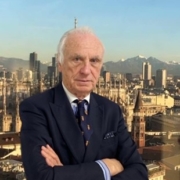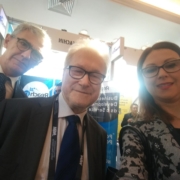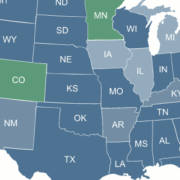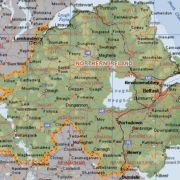A virtual coffee with Riccardo Fuochi, an illustrious protagonist of national and international luxury logistics.
We stopped in Milan, this time to talk about another fundamental theme for recovery, always drinking a virtual coffee to consume while we talk with another illustrious guest. We wanted to reserve a space of conversation on one of the fundamental clusters of Italian economic life: culture and art, undisputed symbols of a Country, ours, which boasts an absolute primacy for history, for historical artifacts, for illustrious undisputed artists and geniuses that the whole world envies us. Let’s not exaggerate if we say that more than half of the artworks exhibited in museums around the world are attributed to Italian artists.
Culture, in our country system, accounts for about 6% of GDP. The sector is certainly not a discovery, it is an extraordinary driving force for the other production sectors connected to it and above all it is one of the key factors in attracting tourists from all corners of the world.
Internationally, Italy is recognized as a leader and the movement of foreign tourists who choose to enjoy our artistic assets every year, to visit our cities of art, our places of culture, is the incontrovertible proof of this. Our added value doesn’t stop there. We are a real open-air museum, a natural scenario capable of catapulting the visitor into every historical era. We could define Italy as a “Special Cultural Zone” which lacks an official recognition that takes into account the enormous potential of the system capable of “boosting” the economic system, combining tax exemption efficiency and the artistic heritage supplied. Where, if not in our beautiful Italy, we reiterate in all respects definable as a special cultural area, it is possible to draw from the culture, from the history of the inherited artistic heritage, from the breathtaking landscapes, from the food and wine culture of the UNESCO heritage, direct and induced economic advantages with efficient taxation and deburocratization policies? We launch a provocation that we hope will be caught by those who work in the cultural system. In addition, to stimulate the interest of potential investors … Montecarlo, Luxembourg, Geneva, Singapore, Dubai. What do these cities have in common? All have free zones for works of art that allow the artistic heritage of collectors and investors from all over the world to be guarded, transferred, protected and preserved in a protected atmosphere. Not only. Within these free zones it is possible to buy works of art and valuable goods without the application of customs duties and indirect taxes. Of course, it is necessary that these “special areas” operate in the transparency of the operations guaranteeing all parties and, above all, legality. It would also allow to further increase the professionalism of the artistic evaluation services, the recovery of artistic assets located in numerous caveau (usually managed by banks) and concentrate them in a single place that guarantees not only confidentiality but also a set of logistic services that are essential for the conservation over time and space of the works kept. Moreover, the 2018/843 directive on anti-money laundering requires strict checks on the actual beneficiaries of the asset in order to avoid twisted maneuvers that, through fictitious attribution systems, conceal sinister illegal operations. The combination of free zones, including Special Economic Zones, and logistics in this case becomes the efficient solution capable of protecting and protecting artistic and valuable goods without risk to the owner and without the value of the asset itself being reduced due to damage or transport trauma, but there are also enormous advantages for the entire museum circuit. We welcome our virtual coffee to another exceptional guest known all over the world. Today Riccardo Fuochi is with us, who is an important point of reference in the logistics supply chain sector, positioned on the luxury brand segment, which is essential in the evaluation of artistic works, in their storage and in their handling.
RALIAN: Dr. Fuochi, you are an institution in the logistics sector, in particular among many things, you are president of OLG international sarl based in Chiasso and president of the International Propeller Club of Milan. What does your business do and what does the activity of the Propeller Club consist of?
Dott. Fuochi: OLG International is an international company born after having acquired a long experience in the fashion logistics sector for the main luxury brands. Its main office is in Chiasso, where there is a logistics center for works of art, fine wines and precious objects with a development also overseas in Hong Kong. We have developed niche know-how for lifestyle logistics. We continue to offer our services to numerous fashion brands, so we take care of following interior design, visual merchandising and events projects, and we have developed a structure capable of offering a series of services related to the world of artworks and precious objects . We follow galleries, collectors, artists and auction houses trying not only to offer purely logistic transport and storage services, but following them in all their packaging needs, customs and ministerial issues, art handling, condition reports, we offer the possibility to restore the works at our facility, photograph them, show them to experts, exhibit them and archive them in blockchain. The Propeller is a cultural association that promotes the meeting and relationships between people who gravitate to the world of shipping, transport and logistics. It favors training and technical and cultural updating among all those belonging to the economic and professional categories that gravitate to the world of shipping, transport and logistics, organizing meetings, conferences, events, missions also at an international level. Among the most important events I would like to mention the Shipping Weeks in Genoa and Naples and the Shipping Meets Industry in Milan.
Ralian: Culture is the cradle of innovation. Through culture we stimulate creativity and thanks to it we give life to innovation. In your opinion, is culture perceived in our country as a real cluster or do we still have an obsolete vision of its multiplicative potential on the economic system?
Dr. Fuochi: The current emergency has certainly been positive in this respect, it has accelerated innovative and digital development in all sectors, including the cultural one. Certainly culture is perceived as a cluster in its own right, but an evolution is also necessary in this sector to allow the dissemination and creation of international projects. Museums are creating beautiful innovative and digital projects, as well as private galleries. The range of action is decidedly wide, but somewhere you have to start.
Ralian: Creativity and art have always been the highest form of beauty, of human expression. Very often immortal masterpieces have been inspired by human and social hardships, by situations of suffering in the body and spirit, sometimes they have been the denunciation of an injustice, the awareness of a necessary turnaround that has inspired whole epochs of our humanity. It is therefore the highest expression of resilience. In this complicated period in which an unprecedented economic depression is feared, how can art help us and how can it be made accessible to everyone, so as to spread its beneficial and resilient message?
Dr. Fuochi: By educating people to appreciate art in all its expressions, visual arts, performing arts, theater, cinema, music, dance by combining various forms within paths, events, manifestations and combining them with local traditions, thus involving the whole population . All this also aimed at improving living conditions, respecting the environment and culture of the individual territories.
Ralian: What does Italy need to ensure that the art sector, of which our country is the natural cradle for authors, finds, history, landscape beauty, find a leading role in the economic system?
Dr. Fuochi: “culture is the only good of humanity which, divided among all, instead of decreasing becomes greater.” [Cit. Hans Georg Gadamer]
Enhancement. Italy is the country with the largest concentration of artistic and cultural heritage in the world, but not only the historical and past one that attracts tourists from all over the world every year, but also the contemporary one. There are many young people who train every year in our academies to improve their artistic expression and break the canonical schemes and be appreciated by those who observe their works. There are certainly many interesting initiatives, but the enhancement and importance of our territory rich in villages, monuments and historic centers could be further improved and redeveloped and recovered. There is no corner of our country from which beauty, history and culture do not emerge. This immense heritage must be recovered with economic and fiscal measures aimed at attracting investments, including from private individuals, to encourage cultural, artistic and commercial activities, creating areas that we could define as real “special cultural zones”, paraphrasing the concept of SEZs.
Ralian: What do you think are 5 artworks that can help us to understanding that the greatest beauty can come from the ugliest and most complicated things to deal with?
Dr. Fuochi: There are many artworks that can express these feelings. It is inherent in the soul of the artist to be inspired by moments of difficulty to express values of hope and beauty. I could represent some great masterpieces such as:
1. the flagellation of Christ by Piero della Francesca, describes the Christian ignavia in the face of the Turkish advance preceding the fall of Constantinople. The realization will lead to the union of papacy and empire and to the battle of Lepanto.
2. the deposition of Christ by Raffaello, Atalanta rejected his son Grifonetto, who through insane jealousy had participated in the massacre of the red wedding of the Baglioni of Perugia. The repression led him to death and his mother mourned him and made Raphael commemorate him representing him as a divine young man, who bears the feet of the dead Christ … maternal love …
3. massacre of the innocent, by Rubens, the reference to the wars of religions that tormented Antwerp and Flanders, with thousands of innocent civilians killed, is expressed as a beastly madness in Rubens’ masterpiece, whose commitment to peace has always been very vivid
4. Giuditta and Holoferne of Caravaggio The Jewish widow Giuditta beheads the Babylonian general Holoferne: there are many interpretations, but it is certain that reluctant Giuditta performs the will of God for the liberation of her people, which can also be read as a victory of purity, represented by the young and beautiful heroine, on brute force.
5. Guernica of Picasso 1937 German bombing of the Spanish city that upsets French public opinion and leads Picasso to express his disdain in the masterpiece exhibited immediately in Paris at the universal exhibition, helping to awaken free souls and support the indomitable spirit that resisted the subsequent defeat and occupation
Ralian: You deal with logistics. How do you combine this sector with that of culture, art and what do you think are the best practices to consider for an optimization of the entire reference cluster?
Dr. Fuochi: Have you ever wondered how works arrive in museums, how do loans between countries take place for exhibitions? Rather, what happens from the moment a collector buys a work in a gallery and ends up in our house? Here is the link between the logistics sector and the art sector. We take care of this. First of all to create a relationship of trust with the interlocutor – gallery / collector / personal assistant / banks / art advisor / artists – and to be able to assist him in all operations, without leaving him any worries, but rather reassuring him and working in the utmost confidentiality. We take care of training people in the best possible way so that they are able to handle the works of art and assist customers: we start with a documentary check to verify that everything is in order or to request what is necessary, we create the suitable packaging for transport, we draw up a condition report when we collect and when we deliver the work, we take out insurance, we evaluate the means to be used and the number of people necessary for transport, we employ a team of art handlers who can take care of the installation. In short, we follow all the aspects that allow us to transfer the works with the utmost attention from one place to another.

We thank Dr. Fuochi for sharing his expertise with us and for allowing us to draw many ideas for a relaunch of the culture sector, as expressed at the beginning of the article.
We are preparing for another virtual coffee and we will see you soon.
RALIAN Research & Consultancy srl
© Copyright 2020. All Rights Reserved





